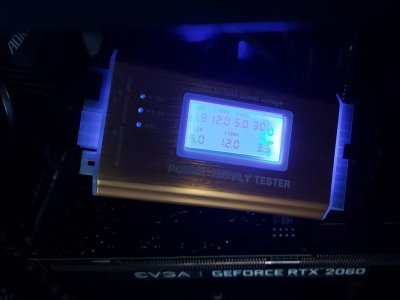Hello,
I have custom-built my PC 1.8 years ago. Played video games for about half a year and then occasionally used PC for browsing, watching YouTube. One day I could not wake my PC from standby because when I pushed power button, nothing happened. After disassembly and testing motherboard, CPU, PSU and video card I still could not power it on but Aorus logo was turning on motherboard. PSU's fan was spinning after I used paperclip method and power readings were stable on multimeter.
Availed of my warranty and shipped motherboard and PSU to PC repair lab of my retailer I bought from. After several tests I was called and told everything works but after receiving it back I still couldn't power it on. Took it to local electronics repair and was told PSU works after they checked it with digital PSU tester. Took it to PC repair shop and paid for testing. They told me PSU and motherboard work without issues. I couldn't believe it because it didn't work earlier at my home. Thought it was power lines issue I took it to neighbor who lives in my apartment. I couldn't power on. I was just about to order new PSU and decided to power on again. To my big surprise everything worked and I had no problems since.
Yesterday, 10 months later of non-video gaming and very light use like browsing internet, watching YouTube 2-3 times per week for 1-2 hours every time on average my PC restarted itself after I woke up my monitor and clicked on some photo in Chrome. It was unusual restart because Aorus logo was lit but fans weren't spinning for about 5-10 seconds and then worked. PC booted OS and a couple of minutes after logging in it restarted again. This time while booting OS it restarted again. I entered BIOS and left it on idle but after 3 minutes PC restarted again.
I shut it down, flipped I/O case switch, unplugged from UPS to mains. Disconnected UPS USB cable and LAN cable from case. Flipped I/O case switch, entered BIOS and after a couple of minutes PC restarted again. I shut it down but now I could no longer power it on like in last incident. Aorus logo turns on motherboard though.
I don't know what I should do. Ship PSU and motherboard to retailer's PC lab only to be told everything works? Seems like I might be dealing with an issue that occurs random. I don't have someone to borrow PSU from and small digital tester for PSU which I could go buy locally or from China. Maybe it could show me if there is any power instability in PSU? What if I order new PSU but problem is actually in motherboard?
Thanks.
CPU: AMD Ryzen 5 3600X
MB: Gigabyte B450 Aorus Elite
GPU: EVGA GeForce RTX 2060
RAM: 8x2 Corsair Vengeance LPX 3200MHz
PSU: Corsair TX650M
I have custom-built my PC 1.8 years ago. Played video games for about half a year and then occasionally used PC for browsing, watching YouTube. One day I could not wake my PC from standby because when I pushed power button, nothing happened. After disassembly and testing motherboard, CPU, PSU and video card I still could not power it on but Aorus logo was turning on motherboard. PSU's fan was spinning after I used paperclip method and power readings were stable on multimeter.
Availed of my warranty and shipped motherboard and PSU to PC repair lab of my retailer I bought from. After several tests I was called and told everything works but after receiving it back I still couldn't power it on. Took it to local electronics repair and was told PSU works after they checked it with digital PSU tester. Took it to PC repair shop and paid for testing. They told me PSU and motherboard work without issues. I couldn't believe it because it didn't work earlier at my home. Thought it was power lines issue I took it to neighbor who lives in my apartment. I couldn't power on. I was just about to order new PSU and decided to power on again. To my big surprise everything worked and I had no problems since.
Yesterday, 10 months later of non-video gaming and very light use like browsing internet, watching YouTube 2-3 times per week for 1-2 hours every time on average my PC restarted itself after I woke up my monitor and clicked on some photo in Chrome. It was unusual restart because Aorus logo was lit but fans weren't spinning for about 5-10 seconds and then worked. PC booted OS and a couple of minutes after logging in it restarted again. This time while booting OS it restarted again. I entered BIOS and left it on idle but after 3 minutes PC restarted again.
I shut it down, flipped I/O case switch, unplugged from UPS to mains. Disconnected UPS USB cable and LAN cable from case. Flipped I/O case switch, entered BIOS and after a couple of minutes PC restarted again. I shut it down but now I could no longer power it on like in last incident. Aorus logo turns on motherboard though.
I don't know what I should do. Ship PSU and motherboard to retailer's PC lab only to be told everything works? Seems like I might be dealing with an issue that occurs random. I don't have someone to borrow PSU from and small digital tester for PSU which I could go buy locally or from China. Maybe it could show me if there is any power instability in PSU? What if I order new PSU but problem is actually in motherboard?
Thanks.
CPU: AMD Ryzen 5 3600X
MB: Gigabyte B450 Aorus Elite
GPU: EVGA GeForce RTX 2060
RAM: 8x2 Corsair Vengeance LPX 3200MHz
PSU: Corsair TX650M
![[H]ard|Forum](/styles/hardforum/xenforo/logo_dark.png)
